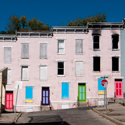 |
The Detroit Institute of Arts recently installed "framed reproductions of forty of its most famous works to the main streets and landmark outdoor spaces" of metro Detroit in celebration of the museum's 125th anniversary. Fittingly, they placed a reproduction of Frederic Edwin Church's massive Syria by the Sea in front of the ruins of the Michigan Central Station.
My daughter had a play date in the neighborhood yesterday evening so the boy and I took the dog for a walk over to the station. It was cool to watch people stopping to take pictures and reacting to the image in the lovely garden that was installed in front of the station last summer. (You will forgive me for cranking up the warmth in the photo I took of the installation, I hope).
This is exactly the sort of thing the city needs to be doing with respect to its tourist-attraction ruins, and I even talked about this very painting in relation to the station at the talk I gave last summer. I have to give credit to one of my favorite writers, Geoff Dyer, for first making the comparison in an excellent essay from his book Yoga for People Who Can't Be Bothered to Do It (2003):
The painting. . .showed ruined columns of antiquity bathed in the elegaic light of the declining sun. A caption explained that the painting depicted "a civilization in ruins, succumbing to the forces of nature. The crumbling buildings, overgrown with vegetation, symbolize nature's power over humanity and its structures."
This picture was much in my mind as I drove from the Institute of Arts to the Michigan Central Railroad Station. . .It occurred to me that Church's picture might have been acquired with some Dorian Grayish motive in mind---the ruination of the painted city guaranteeing the Motor City's eternal prosperity---but it ended up being an allegory or prophecy of Detroit's decline and fall, a decline and fall exemplified by the Michigan Central Railroad Station. . .
I parked in front of the station and walked over to a couple of people who were taking photographs.
"Oh, we're just here photographing," said the woman, "hoping someone would pull up and park a white car slap in the middle of the picture." I looked at my car. It was an unbelievably stupid place to have parked but, eager to enter into a dialogue, I said, "Actually, I parked there entirely for your benefit."
"You did?"
"You will recall that in Caspar David Friedrich's paintings there is usually a lone figure, a monk, say, in front of the ruined abbey or -- in the most famous example -- in the middle of the beach. The small figure gives a sense of focus to the fathomless longings of German Romanticism. In the case of post-industrial ruination a human figure would be inappropriate but a car -- a white Ford, mind you -- might be just what you need, compositional and symbolically."
I had captured the intellectual high ground but I had not succeeded in regaining the lost ground of common courtesy. "I'll tell you what," I added. "I'll move the car."
This image is Copyrighted. No unauthorized reuse.

